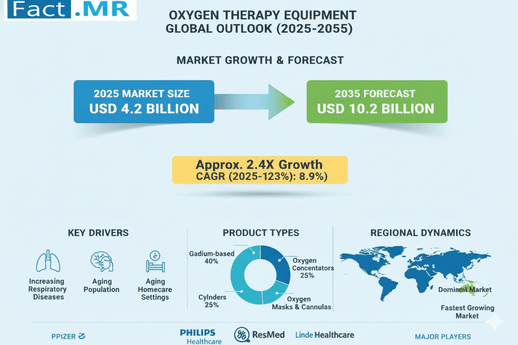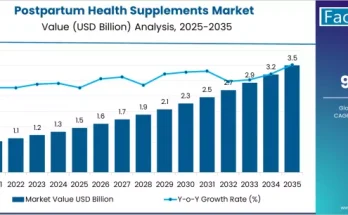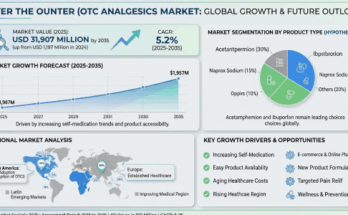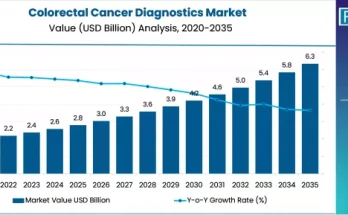The global oxygen therapy equipment market is on a robust growth trajectory, projected to increase from USD 4.2 billion in 2025 to USD 10.2 billion by 2035, registering a CAGR of 8.9% over the forecast period. Fueled by the rising prevalence of chronic respiratory diseases, expanding geriatric populations, and growing awareness of home-based oxygen therapy solutions, the market is witnessing an unprecedented transformation across clinical and homecare settings.
Oxygen therapy, a cornerstone of respiratory care, is increasingly becoming an integral part of patient management for conditions such as COPD, asthma, and cystic fibrosis. In addition, post-operative recovery and COVID-19 convalescence have accelerated demand for non-invasive oxygen delivery solutions. Physicians and healthcare providers are increasingly favoring portable, easy-to-use systems capable of continuous oxygenation and real-time monitoring.
Oxygen Therapy Equipment Market Dynamics and Technological Advancements
Innovation continues to shape competitive advantage in this high-growth sector. Industry leaders are focusing on enhancing device portability, ergonomics, and integration with digital health platforms. Features such as app-enabled monitoring, Bluetooth connectivity, and user-friendly interfaces are transforming patient adherence and enabling remote care.
Portable oxygen concentrators (POCs) are gaining significant traction due to their convenience for mobile patients, particularly among the elderly and those requiring long-term therapy. Meanwhile, stationary oxygen devices remain critical for high-flow applications in hospitals and homecare setups, supporting continuous oxygen therapy for chronic respiratory patients.
Emerging markets, particularly in Asia-Pacific, are witnessing a surge in adoption due to improved healthcare accessibility, rising disposable incomes, and government initiatives supporting home-based care. Green technology integration, including energy-efficient concentrators and sustainable materials, is further positioning products to meet both patient and environmental expectations.
Oxygen Therapy Equipment Market Regional Outlook
North America leads the global oxygen therapy equipment market, driven by high healthcare expenditure, well-established hospital infrastructure, and favorable reimbursement policies. The U.S. market alone is expected to expand at a CAGR of 7.6% over the forecast period, with portable and home-use oxygen devices becoming a mainstream solution.
Europe demonstrates steady growth at a projected CAGR of 6.5%, driven by strong healthcare systems, technological readiness, and patient-focused initiatives. The UK and Germany are spearheading adoption of app-enabled oxygen devices and smart concentrators, emphasizing patient mobility and compliance.
Asia-Pacific is set for the fastest growth, with China projected at 8.1% CAGR. Urbanization, rising air pollution, and increasing incidence of respiratory conditions are driving demand. Local manufacturers are providing scalable, cost-effective oxygen solutions while integrating smart monitoring technologies to improve accessibility and adherence.
Japan, South Korea, and Australia-New Zealand markets are also poised for steady expansion, supported by aging populations, advanced healthcare infrastructure, and rising awareness of chronic respiratory management.
Oxygen Therapy Equipment Market Segment Analysis
-
By Portability: Stationary oxygen devices dominate with a 61.4% market share, owing to high oxygen output and suitability for long-term homecare. Portable devices hold 38.6% of the market, reflecting rising patient preference for mobility and convenience.
-
By Product: Oxygen source equipment, including concentrators and liquid oxygen systems, accounts for 51.2% of the market, while oxygen delivery devices—including nasal cannulas, face masks, and tubing—constitute 48.8%. The growth of delivery devices is driven by the need for precise, comfortable, and adaptable patient-centric solutions.
-
By Application: Chronic conditions such as COPD, asthma, and cystic fibrosis are primary growth drivers. Increased incidence of pneumonia and other respiratory illnesses also fuels device adoption.
-
By End-User: Hospitals remain key consumers; however, the homecare segment is experiencing rapid expansion, reflecting a shift toward decentralized care.
Oxygen Therapy Equipment Market Competitive Landscape
The oxygen therapy equipment market is characterized by a mature yet innovative competitive environment, emphasizing product differentiation through portability, digital integration, and patient-centric design.
-
Philips Healthcare (18-21%) leads with comprehensive stationary and portable concentrator lines integrated with digital health features.
-
Inogen, Inc. (15-18%) specializes in ultra-portable devices and direct-to-consumer strategies, enhancing patient independence.
-
Teleflex Inc. (13-15%) focuses on hospital-integrated respiratory solutions, including high-flow nasal systems and masks.
-
Drägerwerk AG & Co. KGaA (10-12%) delivers intelligent ventilation and precision oxygen systems for critical care.
-
Chart Industries, Inc. (8-10%) strengthens the market with cryogenic oxygen solutions bridging clinical and homecare settings.
Other notable players include Smiths Medical, GE Healthcare, Invacare Corporation, Linde Healthcare, Fisher & Paykel Healthcare Ltd., and Taiyo Nippon Sanso Corporation, all contributing to a competitive ecosystem fostering continuous innovation and patient outcomes improvement.
Oxygen Therapy Equipment Market Future Outlook
The period 2025-2035 is expected to witness significant technological convergence in oxygen therapy, with devices becoming smarter, smaller, and digitally connected. Artificial intelligence and predictive analytics will optimize oxygen delivery, while telehealth integration and homecare adoption will redefine chronic respiratory management. Sustainability and energy efficiency will continue to influence product design and market positioning.
As the global population ages and respiratory health gains prominence, oxygen therapy equipment will remain a critical component of both hospital and homecare ecosystems. Industry players that prioritize innovation, patient-centric design, and regional adaptability are well-positioned to capitalize on the projected USD 10.2 billion market by 2035.
About Fact.MR
Fact.MR delivers actionable market intelligence for business leaders, enabling data-driven decisions and strategic growth planning. Their research covers global markets, including emerging and mature economies, with a focus on technological trends, regulatory landscapes, and competitive analysis.
Browse Full Report : https://www.factmr.com/report/oxygen-therapy-equipment-market



